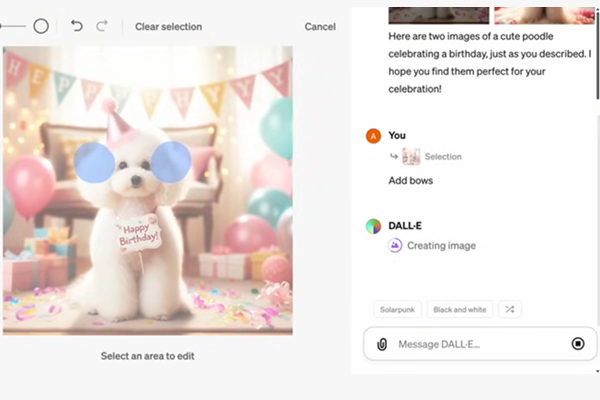ChatGPT Adds Editing Tools to DALL-E Synthetic Images
OpenAI has augmented its synthetic image generator DALL-E with a pair of updated and improved features. The more significant change brings editing options to DALL-E images produced within ChatGPT, allowing for spot adjustments to images, as seen in the video above. The other update brings preset style suggestions to the engine, a shortcut for those who want a certain style and would rather click from the selection than write it out themselves.
ChatGPT DALL-E
People creating images through ChatGPT’s website or mobile app will be able to use the editing tool if they subscribe to ChatGPT Plus. The upgrade embeds editing tools to alter bits of an image without having to generate an entirely new one from scratch. Integrating DALL-E into ChatGPT streamlined synthetic image generation by letting users ask the AI for help with their prompt. Doing the same with the editing feature furthers that process by cutting out the need to recreate an image with small changes from a blank canvas each time.
The second enhancement comes in the form of preset style suggestions for image creation. DALL-E now offers a range of style prompts, such as gothic, hand-drawn, and woodcut. Examples accompany the choice to help users decide what they want. That said, the style suggestions are clearly pitched as starting points, with plenty of room for users to refine them to meet their vision.
The updates pair well with the ways OpenAI has been addressing concerns about the trustworthiness and authenticity of synthetic images. The company added visible watermarks and metadata into to DALL-E images earlier this year to label their synthetic origins. While this represents a step towards transparency, challenges remain, particularly regarding the ease with which these markers can be removed by individuals with malicious intent.
The expansion of DALL-E features on ChatGPT is part of a wave of recent updates and improvements to the generative AI chatbot aimed at making it more accessible and user-friendly. Just this week, OpenAI announced that ChatGPT no longer requires users to create an account and sign in. Those who don’t have an account are able to use the free version of ChatGPT, which employs OpenAI’s GPT-3.5 large language model. The user can return to the chatbot, though the AI won’t save any information between these anonymous sessions.
That news came after ChatGPT added the Real Aloud feature for making an audio performance of ChatGPT’s answers in 37 languages and five voices. ChatGPT also has a fairly new memory setting that can be used to tailor how it interacts with users based on previous conversations. Recalling preferences and personal information reduces the need for repetition by the user at the beginning of every conversation. That followed the ability to invoke custom GPTs during a conversation, chat archiving, and the release of new models designed to make ChatGPT work harder. All of this builds on earlier features like online search and multimodal options that allow for verbal conversations and enable the AI to process images and perform document and PDF analysis.
Follow @voicebotaiFollow @erichschwartz
ChatGPT No Longer Requires Log-In as OpenAI Tries to Broaden Generative AI Chatbot User Base
OpenAI Teases DALL-E 3 Text-to-Image Generator Built Into ChatGPT









